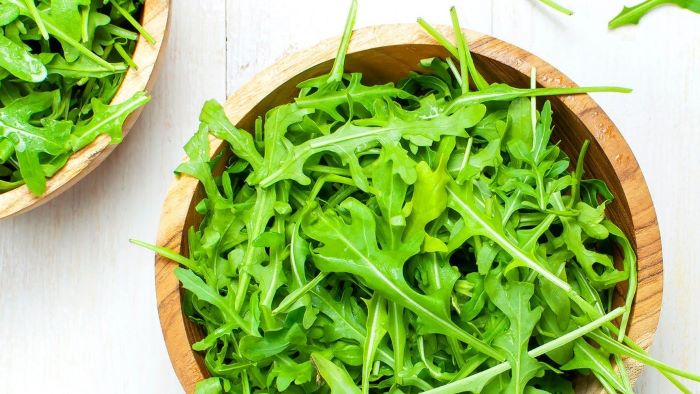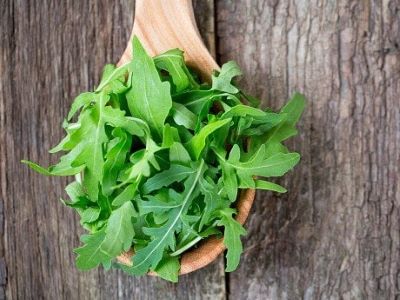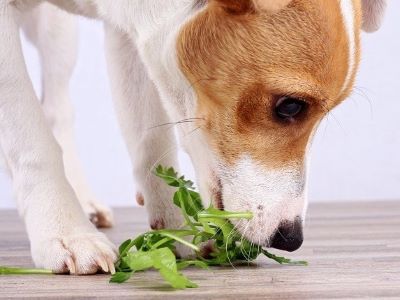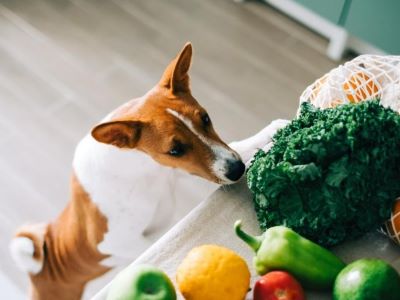Arugula is a nutritious leafy green vegetable. While humans can eat a variety of vegetables, what about dogs? Can dogs eat Arugula?
Understanding what foods can our dogs eat is important. In this blog, we are going to understand about arugula and whether or not our dogs can eat this or not. So, without any further ado let’s begin…

Can Dogs Eat Arugula?
Yes, dogs can eat Arugula. Arugula is generally safe for dogs to eat. As omnivores, dogs can eat both plant and animal foods. Vegetables like arugula provide vitamins, minerals, and fibre.
“Arugula contains vitamins A, C, and K plus folate, calcium, and potassium, which support skin, bone, and immune health”, says experts from WebMD.
When feeding arugula, wash it properly and watch for signs of allergies or stomach upset, especially when first introduced.
Feed arugula in moderation and contact your vet if you notice any negative reaction. The key is moderation and variety in a balanced dog diet. Remember, moderation is important so feed them to a limit. If you notice any reaction then quickly contact the vet.
Potential Benefits:
Arugula can fulfil the nutritional needs of dogs. The vitamins and minerals in arugula contribute to overall well-being. The fibres may also help in digestion and promote a healthy gut. However, it's important to remember that arugula should complement, not replace, their regular balanced diet.

Potential Risks of Arugula
Here are some possible risks that may be involved in feeding a dog arugula, let’s understand:
Oxalates
Arugula contains oxalates, which can cause kidney stones in prone dogs[1]. While arugula has lower oxalate levels than some greens, dogs with urinary issues may still be at risk.
If your dog has had kidney or bladder stones, talk to your vet before feeding arugula. They can help decide if arugula is appropriate based on your dog’s medical history. Consulting a vet is key for dogs vulnerable to oxalates.
Stomach Upset
When adding new foods like arugula to a dog’s diet, go slowly to avoid gastrointestinal upset. Start with small amounts and watch for symptoms like diarrhoea, vomiting, or stomach discomfort.
If your dog tolerates it well, gradually increase the quantity fed, while sticking to moderate amounts. Taking it slow allows their digestive system to adjust.
Allergic Reactions
Just like humans, dogs can be allergic to certain foods, including vegetables like arugula. Let’s understand the signs in detail:
- Itching or scratching excessively
- Swelling, especially around the face or paws
- Redness or irritation of the skin
- Hives or welts
- Vomiting or diarrhoea

Regular monitoring is essential when introducing new foods. Monitor your dog’s behaviour, appetite, and bathroom habits. If you notice any sign of distress then consider reducing or removing arugula from your diet.
When to Consult a Veterinarian?
If your dog has concerning or persistent symptoms after eating arugula, or if you are unsure about giving arugula, talk to your vet.
They can advise according to the preferences of your dog’s specific health, breed, and needs.
How to Feed Arugula to Dogs?
Let’s see step-by-step how you can feed arugula to your dog:
1. Washing and Preparing Arugula
Always choose fresh, organic arugula whenever possible. Look for crisp leaves without shrinking or yellowing. Rinse the arugula under cold, running water to remove any dirt, pesticides, or contaminants.
Gently shake or pat dry with a clean towel. To make it easier for your dog to consume, chop the arugula into small, bite-sized pieces. This also helps prevent choking.
2. Including Arugula into a Dog’s Diet
Introduce arugula by mixing it with your dog’s regular food. Start with a small amount, slowly increasing it over time as your dog gets used to the taste and texture.
If you prepare homemade meals for your dog, consider including arugula as part of a balanced recipe. Make sure every meal meets their nutritional needs.
Offer arugula as a standalone snack between meals. This can be a refreshing and nutritious treat, especially on hot days.
3. Avoid Adding Seasonings
When serving arugula to dogs, keep it plain. Do not add any seasonings, spices, oils, dressings, salt, garlic, or onions, as these can be unsafe for dogs[2]. Commercial dressings often contain toxic ingredients.
Plain, unseasoned arugula is the safest option. While arugula itself is low-calorie, avoid adding high-fat toppings like cheese or oils as excess fat may cause stomach upset. Keep it simple for your dog’s health.

4. Additional Tips
When first feeding your dog arugula, watch closely for signs of allergies or stomach upset. Consult your vet before major diet changes, especially if your dog has health conditions.
Start with small amounts of arugula to allow your dog’s system to adjust. Moderation is key – too much of any new food can cause problems. Go slow and be observant.
Alternatives to Arugula
Let’s see what can you feed your dog instead of Arugula:
- Spinach: Nutrient-rich, best cooked to reduce oxalates.
- Broccoli: Packed with nutrients, and antioxidants. Feed in moderation.
- Carrots: Excellent source of beta-carotene for vision. Crunchy, low-calorie treat.
- Sweet Potatoes: Rich in fibre, vitamins, and minerals. Can be cooked, mashed or dried.
- Cucumbers: Hydrating, low-calorie snack. Cut into bite-sized pieces.
- Green Beans: Low-calorie, high-fiber. Serve fresh, steamed or frozen.
- Pumpkin: High fibre for digestion. Great in moderation.
- Zucchini: Low-calorie, a good source of vitamins. Cook or shred as a topping.
- Bell Peppers: Colorful, crunchy, rich in vitamins A and C. Cut into small pieces.
- Celery: Hydrating with high water content. Cut into small, manageable pieces.
Tips for a Balanced Diet for your dogs:
Talk to your vet before making major diet changes, to ensure your dog’s needs are met. For a healthy, balanced diet, mix commercial dog food with a variety of dog-safe vegetables in moderation.
Avoid toxic foods like onions, garlic, grapes, raisins, and certain nuts. When in doubt, check with your vet. The key is balance.
FAQs
❔Are Any Leafy Greens Bad for Dogs?
Lettuce, spinach, chard, cabbage and kale are all okay for dogs. Besides being rich in vitamins A, C, and K, calcium, iron and potassium, leafy greens are also a good source of fibre. Much like humans, dogs get the most nutrients when the veggies are uncooked.
❔Can Dogs Eat Arugula?
Yes, arugula is safe for dogs. Like many leafy green vegetables, arugula doesn’t contain anything toxic to dogs, making it a low-calorie snack with nutritional value. As long as you follow a few guidelines (namely, cooking the arugula and serving it to your dog in moderation), arugula can help boost your dog’s health.
❔Can Dogs Eat Lettuce and Arugula?
In general, yes. Lettuce of the romaine, arugula, and iceberg varieties do not contain ingredients that can harm your dog. After all, lettuce is 90 per cent water and is also a low-calorie snack that could be a good training treat for an overweight dog.
❔What Veggies Can Dogs Not Eat?
The following veggies are considered unsafe for dogs: Garlic, Onions, Shallots, and chives: Garlic, onions, shallots, and chives are toxic to dogs, whether raw or cooked. They have substances that may cause anaemia and damage red blood cells. Signs of illness may take several days to manifest.
❔What Vegetables Can Dogs Eat Every Day?
Pumpkin. Technically, a pumpkin is a fruit because it’s the flowering part of the pumpkin vine. Broccoli. Broccoli is another one of my favourite vegetables that dogs can eat. Kale and spinach. Green beans. Brussels sprouts. Carrots. Zucchini. Sweet potatoes.
Conclusion
In conclusion “Can Dogs Eat Arugula?” dogs can eat arugula. Arugula is a leafy green vegetable that offers several key nutrients.
It contains vitamins A, C, and K, folate, calcium, and potassium. But remember to feed them in moderation so that they may not have any side effects like obesity and digestive issues.
Remember being responsible pet parents you must provide them with healthy foods, after all a healthy dog is a happy dog!
Reference:



